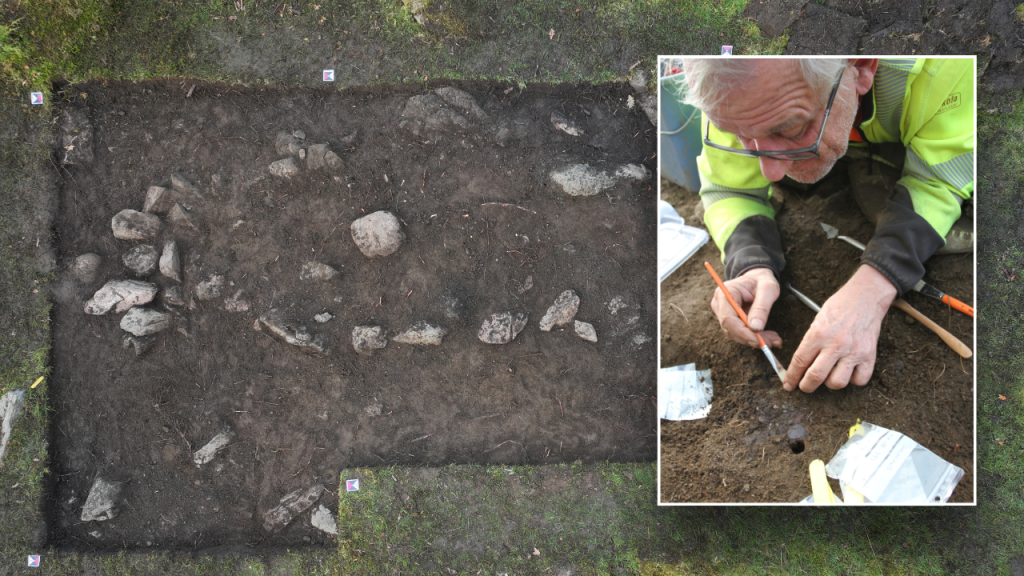The serendipitous discovery of Viking graves at Skumsnes farm in Fitjar, southwestern Norway, has provided archaeologists with a remarkable glimpse into the lives of wealthy Viking women during the 9th century. Uncovered in autumn 2023 by members of the Bjørgvin Detector Club, the graves, dating back to between 800 and 850 A.D., yielded a trove of artifacts, including jewelry, coins, and textile production tools, shedding light on trade, raiding practices, and the social status of women within Viking society. The initial excavation focused on two graves, both belonging to women of apparent high standing.
The first grave, though likely plundered not long after the initial burial, possibly even during the Viking Age itself, contained fragments of gilded oval brooches, indicative of Norse origin, and pieces of a metal cauldron or dish likely manufactured in southern England or Ireland, adorned with enamel inlay and animal-shaped handles. Perhaps the most intriguing artifact was a book clasp, repurposed as a brooch or buckle pin. This clasp, archaeologists surmise, was likely looted from a Christian monastery in the Britannic Isles before the ninth century, demonstrating the Vikings’ opportunistic acquisition of valuable objects, transforming them for their own use. The scattered fragments and broken jewelry suggest a deliberate act of desecration and plunder, rather than simple deterioration over time.
The second grave, spared the plundering that afflicted the first, offered a richer tapestry of artifacts. A collection of textile production tools points to the buried woman’s expertise and leadership in this prestigious and economically significant craft. A bronze key found within the grave further symbolizes her prominent position within the household, likely as the head of the farm. The presence of what appears to be a frying pan reinforces this interpretation. Adorning the deceased were a pearl necklace composed of 46 diverse glass beads, originating from various European and Scandinavian regions, interspersed with 11 silver coins. These coins, dating back to the reigns of Louis the Pious and minted in Jutland, offer tangible evidence of trade networks and interactions between the Vikings and the Frankish empire.
The coins, along with other artifacts, illustrate the complex interplay between trade and raiding in Viking society. While the coins likely represent legitimate trade transactions, the repurposed book clasp serves as a stark reminder of the Vikings’ propensity for raiding and plundering. The artifacts recovered from these graves offer a nuanced perspective on Viking acquisition practices, demonstrating that they engaged in both peaceful exchange and violent appropriation. The presence of items from diverse regions underscores the extensive reach of Viking trade and raiding activities, extending across the British Isles and into continental Europe.
Beyond the two primary graves, archaeologists also examined a third grave, although not fully excavated, which contained a gilded brooch and 25 glass beads. The proximity of these graves and the similarities in burial goods suggest a possible familial connection between the deceased. The discovery of these graves highlights the importance of metal detectorists in archaeological fieldwork. Their initial discovery triggered the excavation, saving these fragile artifacts from further degradation and potential loss due to their shallow burial depth. The archaeologists now face a race against time to excavate the remaining 20 or more graves identified at the site before they succumb to environmental factors and potential looting.
The Skumsnes farm discovery is significant not only for the richness of the artifacts recovered but also for the insights it offers into the lives of Viking women. These women were not simply passive members of society but held positions of authority and possessed specialized skills, contributing significantly to the economic and social fabric of their communities. The artifacts recovered tell a multifaceted story of trade, raiding, craftsmanship, and social status, providing a more nuanced understanding of Viking society during the 9th century. The continued excavation of the site promises to further enrich our understanding of this fascinating period in history.

